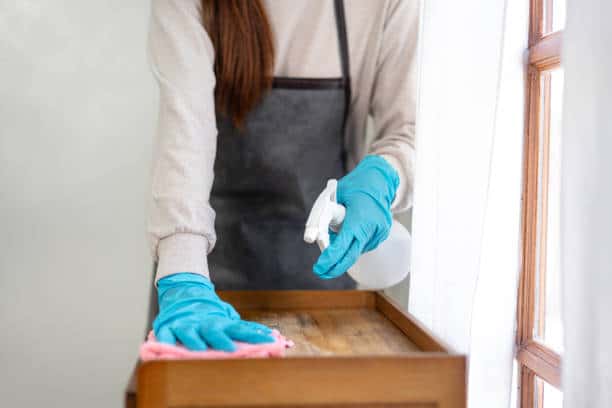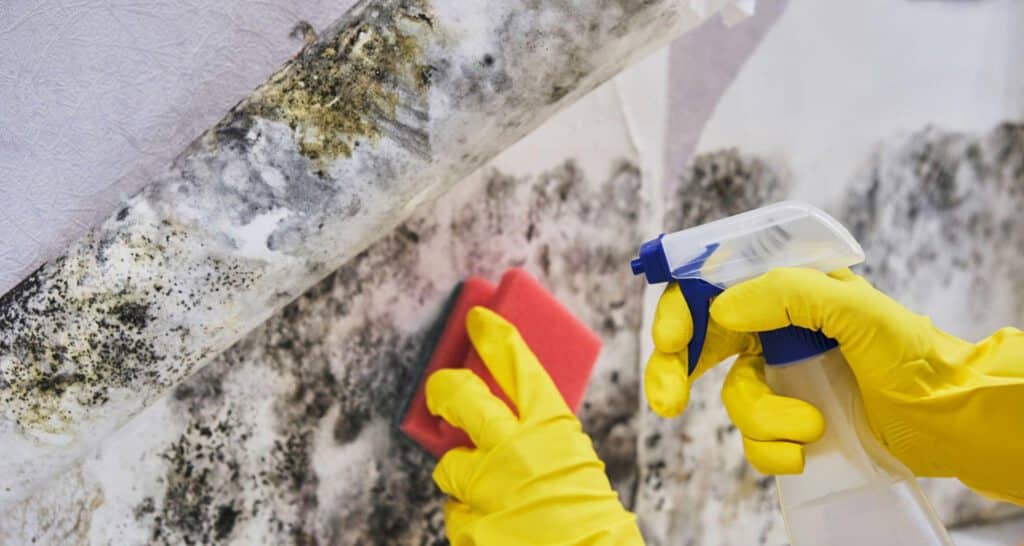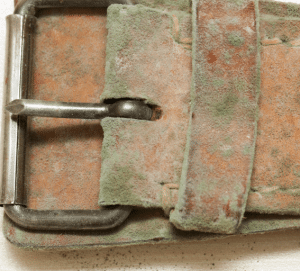Are you wondering how to remove mold from wood furniture? Mold can be a silent but destructive force, slowly degrading the beauty and integrity of your cherished wood pieces.
If left unchecked, this fungal growth can not only mar the appearance of your furniture but also pose potential health risks, making it crucial to address the issue promptly.
Imagine being able to restore the pristine condition of your wooden furniture, eliminating unsightly mold stains and reviving its natural charm. In this comprehensive blog, we will explore proven methods to remove mold from wood furniture, equipping you with the knowledge and tools to tackle this challenge head-on.
What You Need to Know About Mold on Wood Furniture
Mold is not just an ugly sight—it can seriously damage your furniture and affect your health. When mold grows on wood, it can cause stains, weaken the wood, and even lead to structural damage over time. Some types of mold release spores into the air, which can trigger allergies, breathing problems, and other health issues.
It’s important to deal with mold as soon as you notice it. The longer you wait, the harder and more expensive it gets to remove. Knowing the risks of mold will help you take action quickly to protect your wood furniture and keep your home safe.
By understanding these dangers, you’ll be more motivated to address mold issues promptly and effectively, ensuring your wood furniture stays in good condition and your indoor environment remains healthy.
How to Spot Mold on Your Wood Furniture
Before you start getting rid of mold, you need to be sure that’s what you’re dealing with. Watch out for these common signs:
Discoloration
Check your wood furniture for unusual spots or patches. Mold often shows up as green, black, or gray marks. These patches can be small or cover larger areas, depending on how long the mold has been growing.
Musty Odor
Mold has a distinct smell that’s hard to miss. If you notice a damp, earthy, or musty odor around your furniture, even if you can’t see any mold, it might be lurking somewhere out of sight.
Fuzzy or Slimy Growth
Mold can sometimes look fuzzy or slimy, especially in areas that are damp or humid. Run your hand lightly over the wood’s surface – if it feels slimy or you see fuzzy patches, it’s probably mold.
Water Stains or Moisture Damage
Look for areas of your furniture exposed to water leaks or high humidity. These spots are prime locations for mold to start growing. You might notice warping or discoloration in these areas as well.
If you come across these indicators, make sure to address them immediately. Mold can spread quickly and cause more damage if left untreated. Addressing it promptly can save your furniture and prevent potential health issues.
Safety Precautions Before Removing Mold From Wood Furniture
Removing mold from wood furniture requires proper safety precautions to protect yourself and your surroundings. These are the safety precautions you need to follow:
- Ventilation: Ensure adequate ventilation in the workspace by opening windows or using fans to circulate fresh air.
- Protective Gear: Wear gloves, goggles, and a respirator or face mask to avoid inhaling mold spores or exposing your skin to harsh cleaning solutions.
- Containment: Seal off the affected area to prevent mold spores from spreading to other parts of your home or workspace.
- Disposal: Properly dispose of any contaminated materials, such as rags or sponges, in sealed plastic bags to prevent mold growth.
By prioritizing safety, you can minimize the risks associated with mold removal and ensure a successful and worry-free process.
Essential Tools and Materials for Mold Removal
Before diving into the removal process, it’s crucial to gather the necessary tools and materials. Here’s a list of essential items you’ll need:
- Protective gear (gloves, goggles, respirator or face mask)
- Cleaning solutions (see below for natural and commercial options)
- Scrub brushes or sponges
- Vacuum cleaner with HEPA filter
- Plastic sheeting or drop cloths for containment
- Disposable rags or paper towels
- Dehumidifier or fans for drying
Having these tools and materials readily available will streamline the mold removal process and ensure optimal results.
Step-by-Step Guide on How to Remove Mold From Wood Furniture
Follow these step-by-step instructions to effectively remove mold from your wood furniture:
1. Prepare the workspace
Clear the area around the affected furniture, and lay down plastic sheeting or drop cloths to catch any falling debris or spills.
2. Contain the mold
Use plastic sheeting or tape to seal off the area and prevent mold spores from spreading to other parts of the room or home.
3. Remove loose mold
Using a vacuum cleaner with a HEPA filter, carefully remove any loose mold growth or debris from the surface of the furniture. Secure the vacuum bag or canister contents in a plastic bag and discard it properly.
4. Clean the surface
Depending on the severity of the mold growth, you can choose from the following cleaning methods:
- Mild cases: Mix a solution of warm water and mild detergent or soap. Gently scrub the affected areas with a soft-bristled brush or sponge.
- Moderate cases: For tougher mold stains, create a solution of one bleach to three parts water. Spray the solution on the moldy spots and let it soak for 10-15 minutes before scrubbing.
- Severe cases: For stubborn mold growth, you may need to use a commercial mold removal product. Make sure to read and follow the manufacturer’s instructions and keep the area well-ventilated.
5. Rinse and dry
After scrubbing, thoroughly rinse the furniture with clean water to remove any remaining cleaning solution or mold residue. Use a clean, dry cloth or paper towel to wipe the surface and absorb excess moisture.
6. Dry the furniture
Once the surface is clean, allow the furniture to air dry completely. You can use fans or a dehumidifier to speed up the drying process and prevent future mold growth.
7. Disinfect and seal
Once the furniture is completely dry, apply a disinfectant solution or mold-resistant sealant to the affected areas to prevent future mold growth.
Remember, patience and thoroughness are key when removing mold from wood furniture. Taking the time to properly clean and dry the affected areas will ensure long-lasting results and protect your valuable pieces.
Natural Remedies for Mold Removal
If you prefer to avoid harsh chemicals, several natural remedies can be effective in removing mold from wood furniture. Consider these sustainable alternatives:
White Vinegar
The acetic acid in vinegar is a natural mold killer. Mix equal white vinegar and water in a spray bottle and apply it to the affected areas. Allow it to rest for an hour before you start scrubbing and rinsing.
Baking Soda
Make a paste by blending baking soda with water. Apply the paste to the moldy areas and let it sit for several hours before scrubbing and rinsing.
Tea Tree Oil
Known for its antifungal properties, tea tree oil can be an effective mold remover. Add a few drops of tea tree oil to a spray bottle filled with water and apply it to the affected areas.
Hydrogen Peroxide
Dilute hydrogen peroxide with water (1 part peroxide to 2 parts water) and use it to wipe down moldy surfaces. Let it rest for 10-15 minutes before washing it off.
Borax
Mix one part of borax with two parts of warm water and apply the solution to the affected areas. Leave it for a few hours before you start scrubbing and rinsing.
While natural remedies may require more elbow grease and patience, they offer a safer and environmentally friendly alternative for removing mold from wood furniture.

Preventing Mold Growth on Wood Furniture
Once you’ve successfully removed the mold from your wood furniture, it’s essential to take preventive measures to ensure it doesn’t return. Here are some tips to help prevent future mold growth:
- Control Humidity: Mold thrives in damp and humid environments. Use a dehumidifier or air conditioner to maintain a relative humidity level between 30% and 50% in your home or workspace.
- Promote Air Circulation: Proper air circulation can help prevent moisture buildup, which can lead to mold growth. Open windows and use fans to keep the air moving around your wood furniture.
- Promptly Address Water Leaks: If you notice any leaks or moisture issues, address them immediately. Promptly repair any leaks and dry out any affected areas to prevent mold from taking hold.
- Clean and Maintain Wood Furniture: Regularly clean and maintain your wood furniture using a mild soap or wood cleaner. This will help remove any dirt or debris that could provide a breeding ground for mold.
- Apply a Protective Sealant: Consider applying a mold-resistant sealant or wood preservative to your furniture, particularly in high-moisture areas like bathrooms or basements.
By implementing these preventive measures, you can significantly reduce the risk of future mold growth and keep your wood furniture looking its best for years to come.
Professional Mold Removal Services for Wood Furniture
In some cases, particularly with severe or widespread mold infestations, it may be necessary to seek professional assistance. Mold remediation companies have the expertise, equipment, and specialized products to effectively address even the most challenging mold issues.
Here are some situations where hiring a professional mold removal service for your wood furniture may be advisable:
Large-Scale Infestations
If the mold growth covers a significant portion of your furniture or multiple pieces, professional help can ensure thorough and efficient removal.
Structural Damage
If the mold has caused visible structural damage to your wood furniture, a professional assessment and repair may be required.
Health Concerns
If you or someone in your household has a compromised immune system or respiratory issues, it’s best to leave mold removal to professionals to minimize health risks.
Persistent Mold Issues
If you’ve attempted DIY mold removal but the problem persists, it may be time to consult a professional to identify and address the underlying causes.
While hiring a professional mold removal service can be more costly, it can provide peace of mind and ensure the job is done correctly, minimizing the risk of future mold growth and potential health hazards.
Frequently Asked Questions
Can moldy wood furniture be saved?
Yes, moldy wood furniture can often be saved. The key is to address the mold growth as soon as possible. For minor mold issues, you can use household cleaning solutions and proper techniques to clean and restore your furniture. For severe infestations, it might be best to consult a professional mold remediation service to ensure the mold is completely removed and the furniture is preserved.
What kills mold on wood instantly?
Several products can kill mold on wood instantly, such as hydrogen peroxide, baking soda, and commercial mold removers. These solutions penetrate the wood and destroy the mold spores on contact. Be sure to follow the instructions and take necessary safety precautions when using these products.
Does vinegar kill mold on wood?
Yes, vinegar is an effective and natural way to kill mold on wood. It contains acetic acid, which can kill up to 82% of mold species. Simply spray undiluted white vinegar onto the affected area, let it sit for about an hour, then wipe it clean with a damp cloth. For stubborn mold, you may need to repeat the process.
Is it possible to remove mold from wood?
It is possible to remove mold from wood. With the right cleaning solutions and techniques, you can effectively eliminate mold from your wood furniture. Start by cleaning the surface with soapy water, then apply a mold-killing solution like vinegar, hydrogen peroxide, or a commercial cleaner. Scrub the area gently, let it dry completely, and ensure the furniture is kept in a dry, well-ventilated area to prevent future mold growth.
Does vinegar damage wood?
Vinegar is generally safe for cleaning wood and won’t damage it when used correctly. However, it’s important to avoid letting vinegar sit on the wood surface for too long, as its acidity can potentially dull the finish. Always test a small, inconspicuous area first and wipe the surface with a damp cloth after applying vinegar to ensure no residue is left behind.
Conclusion
Reviving the beauty of your wood furniture by eliminating mold doesn’t have to be a daunting task. At Mold Testing Houston, we understand the importance of preserving the integrity and appearance of your cherished pieces. With our proven methods and expert guidance, you can confidently remove mold, restore the natural charm of your furniture, and ensure a healthier environment in your home.
Don’t let mold rob your wooden treasures of their elegance. Take action today and witness the transformation as your furniture regains its original splendor. Trust Mold Testing Houston to provide you with the best solutions and support in maintaining a mold-free, beautiful home. Contact us now to learn more about our services and how we can help you keep your living space pristine and healthy.
Embrace the opportunity to renew your furniture and create a safer, mold-free home with Mold Testing Houston—your partner in exceptional mold removal and restoration.
End Note
Our team at Mold Testing Houston is not just committed to helping you remove mold—we’re dedicated to ensuring your home remains a safe, beautiful haven.
Explore our comprehensive mold inspection services to understand how we can help identify and address mold issues before they escalate. For detailed guidance on our remediation protocols, click here.
Wondering about our extensive service offerings? Visit our services page and discover how we can assist you in maintaining a healthy, mold-free environment. Meet our dedicated team and learn about our mission.
Stay updated with our latest tips and insights by following our Blogs & Articles. Don’t hesitate to contact us today for personalized advice or to schedule a consultation.
Trust Mold Testing Houston to be your partner in creating a clean, healthy, and beautiful home. Let’s tackle mold together and restore the natural beauty of your wood furniture. Visit our website today!





